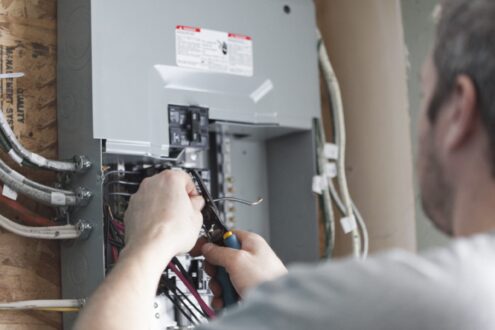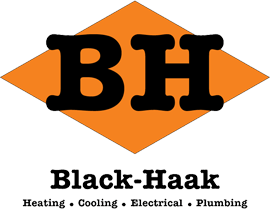
When it comes to electrical systems, many people are at least somewhat familiar with electrical panels and breaker boxes. However, there is often a bit of confusion as to what exactly they are and what sets the two of them apart. All buildings have a main electrical panel, which is often also referred to as the service panel. In most cases, the breaker box is just a part of this panel. However, older electrical systems sometimes have the breaker box in a separate location from the service panel. Some buildings also have an electrical sub-panel that is separate from the service panel and only controls the power to a limited area. In this case, most of the breakers are still in the main panel and the sub-panel only has breakers for a few circuits in one part of the building. With that out of the way, we’ll now provide an overview of all you should know about electrical panels, circuit breakers and how they work.
The Anatomy of an Electrical Panel
The main electrical panel is where power comes into a building, and it houses all of the circuit breakers. Each breaker in the panel controls the power for one of the building’s electrical circuits so that you can shut the electricity off to any circuit when needed. There is also a main breaker in the panel that allows you to shut off power to the entire building. Some newer homes and two-family dwellings also have an additional shut-off switch outside unless the building’s main electrical panel is located outside. This outdoor shut-off has been required by the National Electric Code since 2020, and the purpose is so that first responders can shut off the building’s power and safely enter in case of an emergency.
There are various styles of electrical panels that each look slightly different. If the electrical panel is located inside, it normally looks flat and is recessed into a wall. With this type of panel, all of the wiring is located in a compartment behind the circuit breakers. If the panel is outside, it will normally have another compartment next to the side that houses the circuit breakers. This is where the power comes into the panel, and in most cases, the building’s electric meter is also located directly on this side of the panel.
When you look at an electrical panel, you’ll see that there are two rows of circuit breakers and close to an even number of breakers in each row. The reason that you generally have close to an even number of breakers on each side is to ensure that the building’s electrical load is balanced. If the panel was set up so one side had a much higher load and consistently drew much more power than the other side, you’d end up with an unbalanced electrical load. This is a serious issue since it can overload that side of the panel, causing the electrical components to heat up and potentially get damaged. The bigger concern is that an electrical fire can occur if the panel is overloaded.
When looking at your electrical panel, you’ll also notice that most circuits have a single-pole breaker. Almost all buildings also have at least a couple of double-pole breakers that take up two slots in the panel. The single-pole breakers are for all of the building’s 120-volt circuits, which are all either 15 or 20 amps. The 120-volt circuits are what supplies power to the lights, outlets, light switches and certain hard-wired appliances like a stove and oven. The double-pole breakers control the building’s dedicated 240-volt circuits, which power things like the air conditioning system, clothes dryer, and hot tub. These double-pole breakers range from 20 to 50+ amps, depending on the amperage of whatever is connected to that specific 240-volt circuit.
Why Some Buildings Have Sub-Panels
In many buildings, you’ll also find one or more sub-panels in addition to the main electrical panel. For instance, if there is a detached garage on the property or any other type of outbuilding that has power, it’s fairly common for there to be a sub-panel inside that building or on one of its exterior walls. Having a sub-panel in an outbuilding is more convenient since the breaker or breakers that control the power to the building are located right there. That means you don’t need to walk to the main panel to reset a breaker any time it trips. This is why you’ll also find a sub-panel in many attached garages since you can easily overload a circuit when using power tools, so you often want to have the breaker nearby instead of on the other side of the house in the main panel.
Another reason there will often be a subpanel in this type of setup is that it allows the electricians to just run a single wire to the building when hooking it up to the main electric panel. If the outbuilding had more than one circuit and there wasn’t a sub-panel, the electricians would need to run one wire from the main panel for every circuit. This is why you’ll also commonly find a sub-panel used when putting a major addition onto a building. In this situation, the electricians just need to run one wire from the main panel to the subpanel. They can then connect each of the building’s circuits to the sub-panel so that they can wire the area more quickly and don’t need to use nearly as much wiring and other materials.
How Circuit Breakers Work
Although circuit breakers allow you to shut off the power to any circuit should an issue arise or an electrician need to work on a circuit, their primary purpose is for safety and damage prevention. If too much current flows through a circuit for any reason such as an electric fault, power surge or an overloaded circuit, the breaker will immediately trip. The issue when a circuit gets overloaded is that it causes the circuit’s wiring to quickly get hot, which could result in an electrical fire if power continues flowing through the wires. In cases where the current flowing through a circuit spikes due to a fault or power surge, you can also end up with anything connected to that circuit suffering major damage or getting completely destroyed.
Most circuit breakers either have an electromagnet or a bi-metallic strip that causes them to trip when the current flowing through the breaker rises above a safe level. Inside the breaker are two electric contactors that allow power to flow when the breaker is on. The contactor at the top of the breaker is stationary, and the other contactor moves up or down based on whether the breaker is on or off. For power to flow through a circuit, it needs to be a closed loop where the two contactors are touching. When the circuit gets overloaded, the electromagnet or bi-metallic strip triggers a switch that causes the moving contactor to drop down so that it no longer touches the stationary contactor. This opens the loop or breaks the circuit so that power can no longer flow. When you reset the breaker, it flips the moving contactor back up so that the loop is again closed and power can flow.
With nearly 70 years of experience serving residential and commercial customers in Greenville, Wisconsin, Black-Haak is who you can trust for all of your electrical needs. If you’re having any issues with the electrical panel or circuit breakers in your home or business, our expert team is ready to help you overcome them. Our electrical services also encompass HVAC installations, plumbing repairs, and drain cleaning. To schedule an appointment, contact us today.

